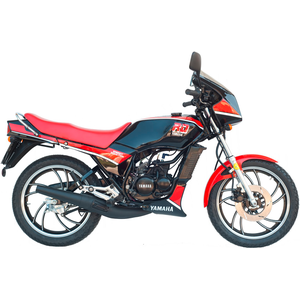Yamaha RD 80 LC [1983-1987] Review: A Two-Stroke Time Machine
Introduction
The Yamaha RD 80 LC represents an era when two-stroke engines ruled the streets – an unapologetically simple, lightweight machine that delivered big grins per cubic centimeter. Produced from 1983 to 1987, this 79cc pocket rocket wasn't just transportation; it was a rite of passage for riders learning the art of wringing out every ounce of performance from modest machinery. Today, it stands as a vibrant reminder of how much fun motorcycling can be when stripped down to its essentials. Let's dive into what makes this LC ("Liquid-Cooled") generation special.
Design & Ergonomics
Yamaha's RD line always had a knack for looking faster than its displacement suggested. The RD 80 LC continues this tradition with its wedge-shaped fuel tank, angular side panels, and that iconic "bumblebee" yellow/black color scheme (though other options existed). The 790mm (31.1") seat height feels accessible for shorter riders, while the narrow chassis (109kg/240lbs wet weight) gives it a bicycle-like flickability.
The LCD dashboard is a period-correct novelty, featuring a speedometer and basic warning lights – no frills, but perfectly legible. Build quality follows Yamaha's 1980s standards: durable enough for daily abuse but not immune to the plastic rattles that plague bikes of this age. The real design star is the liquid-cooling system, with its prominent radiator giving the 80cc engine a surprisingly purposeful look.
Engine & Performance
At its heart beats a 79cc single-cylinder two-stroke engine producing 9.8 PS (7.2 kW) – modest numbers until you experience the 2T powerband firsthand. There's magic in the way power delivery transforms around 5,500 RPM as the exhaust valve opens fully. The engine note changes from a polite putter to an angry hornet swarm, pushing the 109kg machine to a claimed top speed of 100 km/h (62 mph) with some tuck-in commitment.
The 6-speed transmission is a revelation compared to the 5-speeder in earlier RD models. It lets you keep the engine singing in its sweet spot – crucial for maintaining momentum on hills. Fuel economy depends entirely on right-wrist discipline: ride gently and you'll see 30 km/L (70 mpg), but chase that 2T rush constantly and consumption plummets to 20 km/L (47 mpg).
Handling & Ride Experience
Where the RD 80 LC truly shines is in carving up twisty backroads. The 30mm telescopic fork and twin shock rear suspension feel plush over minor bumps but communicate clearly when pushed hard. Tire pressures matter significantly here – Yamaha recommended 1.8 bar (26 psi) front and 2.0 bar (29 psi) rear under normal load, increasing to 2.3 bar (33 psi)/2.8 bar (41 psi) when carrying a passenger.
The 14/48 sprocket combo delivers quick acceleration off the line, though the 118-link chain requires regular adjustment – a small price for the agility it enables. Braking is period-typical: the single 180mm drum rear brake does most of the work, while the front disc (a luxury in this class) offers decent bite once warmed up.
Competition
The RD 80 LC squared off against some iconic names in the lightweight two-stroke segment:
- Suzuki TS50X: More off-road oriented with longer suspension travel, but heavier at 85kg
- Honda MB5: 50cc four-stroke that couldn't match the Yamaha's top-end rush but offered better fuel economy
- Kawasaki AR50: Styling-focused with a rotary disc valve engine, but less refined power delivery
Where the Yamaha excelled was balancing street manners with that authentic two-stroke character. While the Suzuki could handle light trails and the Honda was cheaper to run, none matched the RD's combination of liquid cooling, 6-speed gearbox, and addictive powerband.
Maintenance
Owning an RD 80 LC today requires embracing its two-stroke quirks:
- Oil Injection System: Yamaha's Autolube system mixes 2T oil automatically, but many riders bypass it for premixing (1:50 ratio). We recommend sticking with the original system if maintained properly.
- Spark Plugs: The NGK BR8ES (standard) or BR8EIX (iridium) need frequent checking – that 0.8mm electrode gap is critical for clean combustion.
- Cooling System: Use distilled water with corrosion inhibitor rather than plain tap water to prevent scaling.
- Chain Maintenance: The 14/48 sprocket combo wears faster than modern O-ring chains. Clean with kerosene and lube every 500km.
At MOTOPARTS.store, we stock period-correct maintenance kits including:
- Genuine NGK spark plugs
- DID 118L chains
- Yamalube 2T oil
- 30mm fork seal kits
Conclusion
The Yamaha RD 80 LC isn't about numbers – it's about the visceral thrill of mastering a two-stroke's powerband, the satisfaction of keeping a vintage machine alive, and the smiles it generates wherever it goes. While modern 125cc bikes outperform it objectively, none can replicate the raw, unfiltered character of this 1980s icon.
For current owners, maintaining these bikes is easier than ever thanks to MOTOPARTS.store's comprehensive inventory of OEM-spec components. And for those considering a first vintage bike? The RD 80 LC offers manageable complexity and a huge global community – the perfect gateway to classic two-stroke ownership.



















